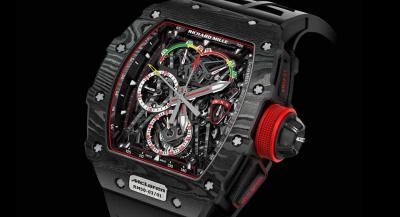In January 2017 the world's lightest mechanical chronograph watch was unveiled in Geneva, Switzerland, made with an innovative graphene-enhanced composite material. Now, the research behind the project has been published. The unique watch was a result of a collaboration between the University of Manchester, Richard Mille Watches and McLaren Applied Technologies.

The RM 50-03 watch was made using a unique composite incorporating graphene to create a strong but lightweight case that contains the watch mechanism, which weighed around 40 grams in total, including the strap. The collaboration explored the methods of correctly aligning graphene within a composite to make the most of the material's superlative properties of mechanical stiffness and strength whilst negating the need for the addition of other, weightier materials.
Project leader Professor Robert Young said, "In this work, through the addition of only a small amount of graphene into the matrix, the mechanical properties of a unidirectionally reinforced carbon fiber composite have been significantly enhanced". "This could have future impact on precision-engineering industries where strength, stiffness and product weight are key concerns such in as aerospace and automotive."
The small amount of graphene used was added to a carbon fiber composite with the goal of improving stiffness and reducing weight by requiring the use of less overall material. Since graphene has high levels of stiffness and strength, its use as a reinforcement in polymer composites shows huge potential of further enhancing the mechanical properties of composites.
The final results were achieved with only a 2% weight fraction of graphene added to the epoxy resin. The resulting composite with graphene and carbon fiber was then analyzed by tensile testing and the mechanisms were revealed primarily by using Raman spectroscopy and X-ray CT scans.
The benefits of this research demonstrate a simple method which can be incorporated into existing industrial processes, allowing for engineering industries to benefit from graphene mechanical properties, such as the manufacture of airplane wings or the body work of high-performance cars.
The research group discovered that when comparing with a carbon fiber equivalent specimen, the addition of graphene significantly improved the tensile stiffness and strength. This occurred when the graphene was dispersed through the material and aligned in in the fiber direction.
Dr. Zheling Li, a University of Manchester research associate, said, "This study presents a way of increasing the axial stiffness and strength of composites by simple conventional processing methods, and clarifying the mechanisms that lead to this reinforcement."
Aurèle Vuilleumier, R&D manager at Richard Mille, said, "This project is a perfect example of technology transfer from the university to the product. The partnership with McLaren Applied Technologies allows a broad diffusion of graphene-enhanced composites in the industry. As a tangible result, a world record light and strong watch was available for our customers: the RM 50-03."
Dr. Broderick Coburn, senior mechanical design engineer at McLaren Applied Technologies, said, "The potential of graphene to enhance composites' structural properties has been known and demonstrated at a lab-scale for some time now. This application, although niche, is a great example of those structural benefits making it through to a prepreg material, and then into an actual product."

